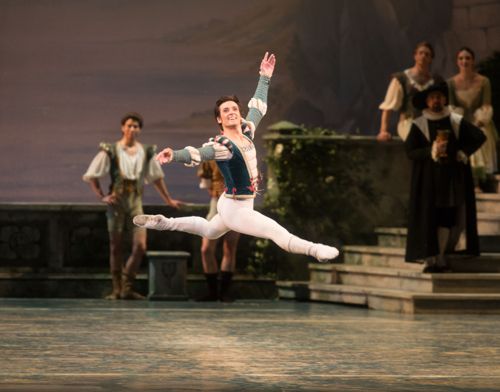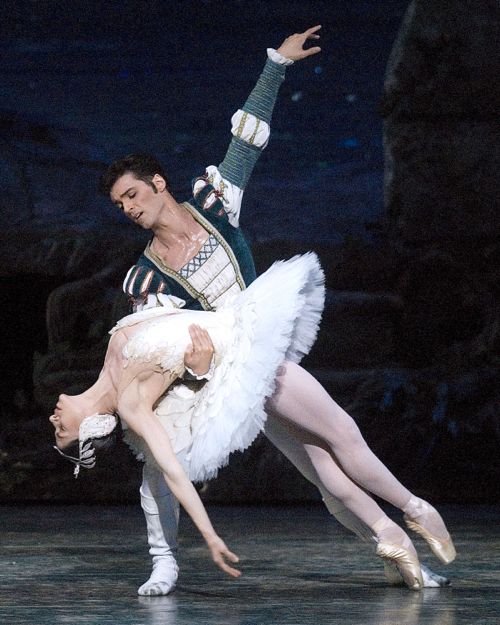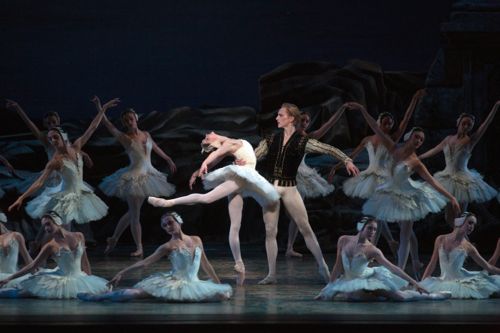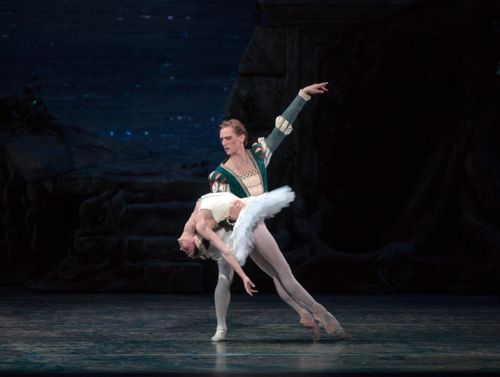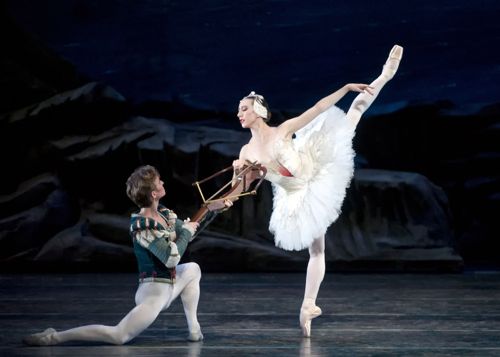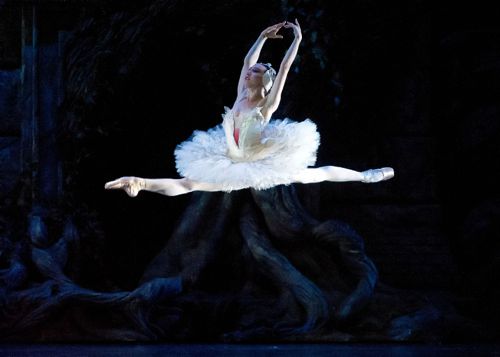
American Ballet Theatre / Metropolitan Opera House, Lincoln Center, NYC / through July 7, 2012
In the past week American Ballet Theatre has been offering a handsome array of dancers to play Odette/Odile and Prince Siegfried in Kevin McKenzie’s version of Swan Lake. Steeling myself against the choreography—as mistaken and misshapen as Peter Martins’ Lake for the New York City Ballet—I chose to see three pairs: Paloma Herrera and Ángel Corella (in his farewell performance with the company); Polina Semionova and David Hallberg (currently dancers in transit); and Isabella Boylston and Daniil Simkin (making their debuts in the roles).
![01_Act I HERRERA CORELLA]() Angel Corella, in his farewell performance with American Ballet Theatre, as Prince Siegfried in Kevin McKenzie’s version of Swan Lake
Angel Corella, in his farewell performance with American Ballet Theatre, as Prince Siegfried in Kevin McKenzie’s version of Swan Lake
Photo: Rosalie O’Connor
Onstage, Ángel Corella has always seemed to be the happiest of men, radiating good cheer and sheer delight. He’s one of those people for whom the glass is neither half full nor full, but eternally brimming over. These qualities—along with an only partly muted version of the masterly dancing that made him a star—were evident in his official farewell performance with the company on June 28th.
He was given the usual send-off: One by one, the artists who have been his colleagues, all known by sight to committed dance fans, appeared to offer flowers and embraces, until the stage was crowded with well wishers, its floor a carpet of blossoms and laurel leaves, the air shot though with glittering confetti. In Corella’s case the routine goodbye ritual was vibrant with the affection his peers feel for him. The audience clapped and cheered wildly, as have so many of Corella’s audiences before, and, for an inordinately long time, even after the house lights went up, steadfastly refused to go home.
Nevertheless, the amazing part of the evening was Corella’s demonstration of his artistry in playing Siegfried. He remains as compelling as ever—you might say even more now that his physical virtuosity is diminished—in sheer theatrical know-how (timing and tone, for instance), and especially in creating a character who is alive at every moment. When his mother, the monarch of the realm in which their story takes place, tells him that, having reached his majority, he’s obliged to marry, he makes it clear and keeps it clear that she has sounded his death knell. He doesn’t go back to the upbeat company of his friends but continues to be shrouded in a dark cloud of gloom. He’s not angry or sulky but rather in what the medicine men of the 20th century would have called a chronic depression.
![2slherreracorella1gsr]() Corella partnering Paloma Herrera as Odette in Swan Lake
Corella partnering Paloma Herrera as Odette in Swan Lake
Photo: Gene Schiavone
Corella appears to be completely convinced by the story the ballet tells. When he does the interpolated solo about being alone in a world that finds companionship easy, he seems to be thinking and moving at the same time. Armed with his crossbow, hunting alone, he encounters Odette and is all amazement. At one point in his pas de deux with her, he leans back as if swooning because he has met sheer loveliness. He seems to believe that a creature so sublime could exist only in the imagination. (As perhaps Odette does, but that’s another interpretation of the tale.) When he climbs the rocky promontory to commit suicide in the wake of Odette’s desperate plunge, he stands poised at the top for a moment, as if getting his emotional bearings, then simply drops into the space below as if there were nothing that could hold him any longer on earth.
As for the technical side of the performance Corella did what he could do without showing strain. It was a lovely “sunset” performance like those of Kyra Nichols in her last seasons with City Ballet, the wise opposite of Nureyev’s in the last decade—or more—of his life. This farewell was one of the greatest performances I’ve seen Corella give and I’ve seen many that were glorious.
Corella’s partner as Odette/Odile, Paloma Herrera, is most gratifying in ebullient roles that show off high spirits and a rock-solid virtuoso technique. She makes a delicious Kitri in Don Quixote, but she’s clearly not a born Odette. She knows exactly what to do in the role but she’s just not fully convincing doing it. She’s a robust creature of the earth, not a figure of enchantment. And, alas, her own technique has begun to erode—just slightly but discernably nevertheless. Oddly enough, she was no more convincing as Odile, even though dynamic divas used to be hers by birthright. In truth, the most touching element in her performance was her devotion to Corella, her long-time colleague and friend.
Corella will continue to dance, he’s announced, with the Barcelona Ballet, still a very green troupe, which he founded and runs because, as he’s said, Spain didn’t have a classical company and should have one.
*
![04_Act IV SEMIONOVA HALLBERG]() Polina Semionova as Odette, partnered by David Hallberg as Prince Siegfried
Polina Semionova as Odette, partnered by David Hallberg as Prince Siegfried
Photo: Rosalie O’Connor
I think of them as the Commuter Couple: Russian-born, Polina Semionova trained in Moscow at the Bolshoi Ballet School. Upon graduation, laden with prizes, she joined the Berlin State Ballet as a principal dancer. She danced with ABT last year and this as a guest artist and has now been invited to join the company full-time as a principal, beginning with its fall season. David Hallberg, an American, trained at the Arizona Ballet School, the Paris Opera Ballet School, and ABT. He became a principal dancer at ABT in 2005 and now divides his time between ABT and the Bolshoi Ballet. The legendary Russian company, jealous of its own importance, is hardly in the habit of adopting foreign artists, yet it took Hallberg on as a star and enhanced the power of his gifts.
The narrative arrangement of Swan Lake lets us find out a lot about Prince Siegfried long before he encounters his enchanted, fatal swan. We meet him enjoying the company of the aristocrats and the peasantry of his long-ago-and-far-away kingdom in the run-up to his coming of age party. There we see immediately that Hallberg’s execution of the classical ballet vocabulary is so flawless that every step he executes looks like a Platonic version of that move.
When Siegfried’s mother presents him with the handsome crossbow for hunting—apparently just what he craved—she also takes him aside to remind him that, upon his coming of age, he’s obliged to marry, although a bride seems to be the last thing he wants. Hallberg makes Siegfried’s feelings apparent and then gets to do, poignantly, the interpolated solo of longing and loneliness. And then he meets his swan, if not the gift of Fate, at least what the casting department has selected for him.
![02_Act II SEMIONOVA HALLBERG]() Hallberg as Prince Siegfried partnering Semionova as Odette
Hallberg as Prince Siegfried partnering Semionova as Odette
Photo: Rosalie O’Connor
Semionova and Hallberg are well-matched in height—she’s tall for a ballerina—although it can be argued that they otherwise make a poorly mated couple. She is all force and unwavering control, while he is lyrical by nature and disposition, and beautifully fluid in both action and in the feelings that lie behind that action. Semionova is an Odette in the line of Cynthia Gregory: technically assured and majestic. She differs from Gregory, alas, in that there’s no plaintive quality in her dancing—no sorrow, no pathos, no feeling of any kind. Even her mime is governed by exactitude. She’s a dancer who is all about control—and perfection within that severe realm. This is not good news.
The pair offered a white swan pas de deux that a dance notator might dream of seeing in the studio to facilitate her job of recording every move in scrupulous detail. The tempo was so clear, careful, and slow—slower even than Makarova famously preferred—that it often felt like stasis. It helped Hallberg look like a better partner than he’s shown himself to be elsewhere, but not an eloquent one.
And what about the Odile part of Semionova’s role, you may well ask. It was just like the Odette part, adorned with a few purportedly wicked grimaces. Semionova’s crackerjack technique serves her well here but, just as she didn’t exude the purity of Odette, she fails to embody Odile’s glittering evil. The multiple fouettés, well seasoned with doubles, were spectacular, though Hallberg outdid her in his gyroscopic response.
*
![5slboylstonsimkin1gsr]() Isabella Boylston as Odette, with Daniil Simkin as Prince Siegfried
Isabella Boylston as Odette, with Daniil Simkin as Prince Siegfried
Photo: Gene Schiavone
Hope and promise were very much in the air, when Isabella Boylston and Daniil Simkin jointly made their debuts in the leading roles at a matinee of Swan Lake. Their technical prowess and professional acumen alone were worth a shower of gold stars.
Because of the way ABT has, quite reasonably, cast him in the past, Simkin—small, swift, strong, and seemingly fearless—has made his mark as a virtuoso. If the McKenzie version of Swan Lake had a jester—as many takes on this ballet do—the role would automatically become Simkin’s. He’d steal the show. Instead, he was given a chance to play Prince Siegfried—though he lacks the height, the looks (he resembles a sweetly appealing child), and the air of command the role calls for. He earned that chance, as was evident in his impeccable rendition of the ballet’s classical-dance passages. Indeed, his perfection of line and the seamless flow of his dancing are very much like David Hallberg’s, but his type—and type remains obdurately significant in yesteryear’s dances, no matter what liberties today’s artistic directors take—still refuses him the keys to the kingdom.
As for acting, he simply doesn’t do it yet and, in general, ABT seems to be oblivious to its importance. This is a self-defeating policy. The absence of drama in the performance of a story ballet means that, beautiful as the dancing may be, nothing about it will feel urgent.
![6slboylston1gsr]() Boylston as Odette
Boylston as Odette
Photo: Gene Schiavone
Isabella Boylston, doesn’t act either, relying on a slight change of how she does the steps to show the difference between Odette (all purity and longing, a role she was born to own) and Odile (an evil seductress, a role that might well contribute to her development). No matter—at least for the moment. Boylston is a consistently lovely dancer, a fact that the company has been slow to recognize fully. Her rendering of the two ladies of the lake was executed admirably, lacking only the kind of magnetism that rivets the attention of a huge audience. This quality is bound to grow with time and experience.
Boylston is petite, with a beautifully proportioned body. Her technique is perfection itself—strong, clear, fluent, and musical to boot. She has only to shed the look of Prize Pupil and take over the territory that is hers by rights. Surely it’s time for ABT to nurture a nascent ballerina of its own making.
© 2012 Tobi Tobias
